Comprehensive Biology Mock Exam: MCQs and Short Answer Questions
VerifiedAdded on 2023/06/18
|21
|3905
|65
Quiz and Exam
AI Summary
This document presents a biology mock exam designed to assess understanding of key concepts. It includes multiple-choice questions (MCQs) covering topics such as cell biology (cell structures and functions), cellular respiration, skeletal and muscular systems, the endocrine and nervous systems, enzyme function, DNA structure, pH balance, dietary components, action potentials, brain regions, and the sympathetic nervous system. The exam also tests knowledge of the thyroid gland, glucagon production, hormone regulation, heart anatomy and function, blood flow, gas exchange in the lungs, digestion, kidney function, the immune system, reproductive biology, genetics, and developmental biology. Furthermore, there are short answer questions focusing on the plasma membrane, urine analysis, antibodies, osmosis, synapses, and the endocrine system. This resource serves as a valuable tool for students to prepare for biology exams, and similar resources can be found on Desklib, a platform providing past papers and solved assignments.
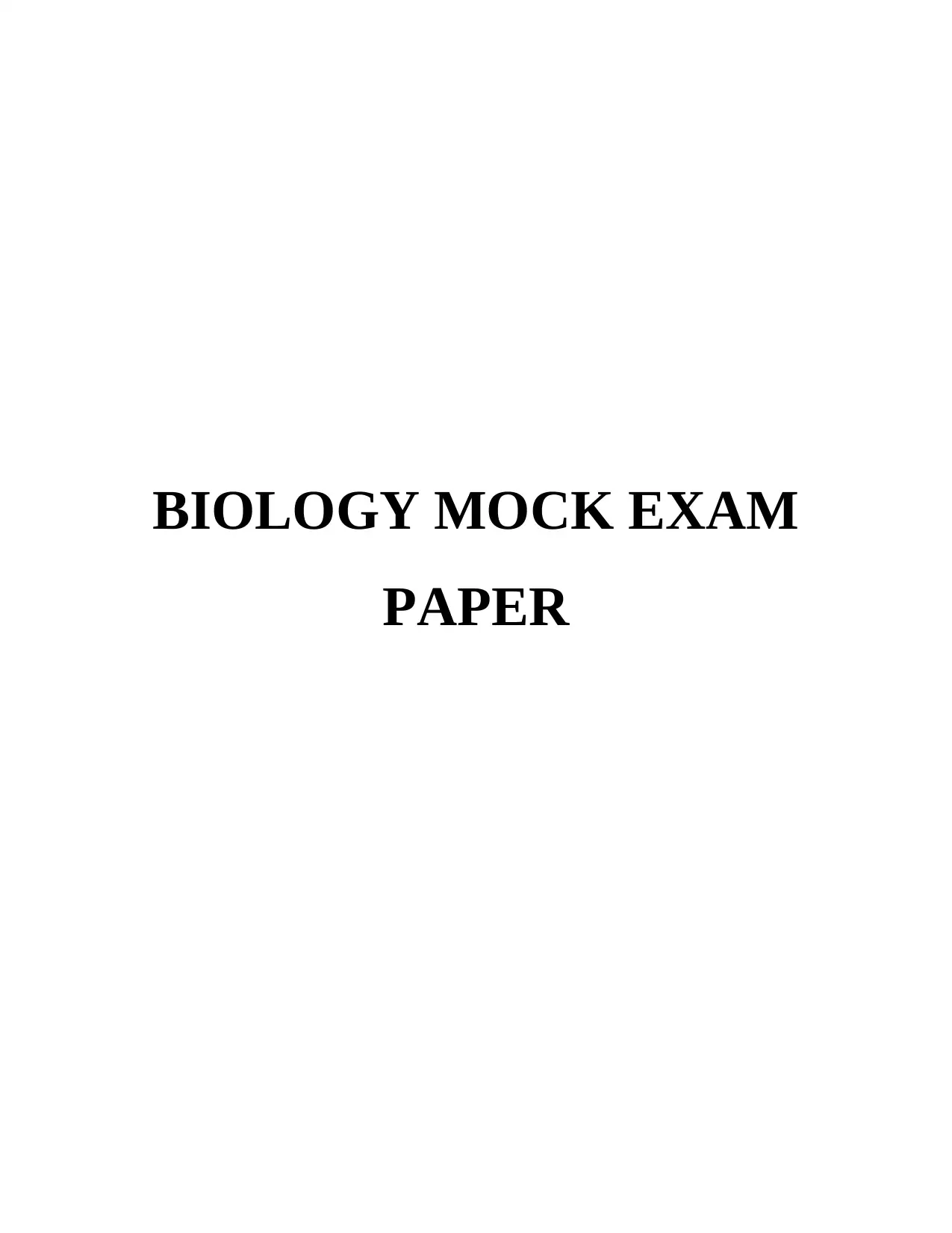
BIOLOGY MOCK EXAM
PAPER
PAPER
Paraphrase This Document
Need a fresh take? Get an instant paraphrase of this document with our AI Paraphraser
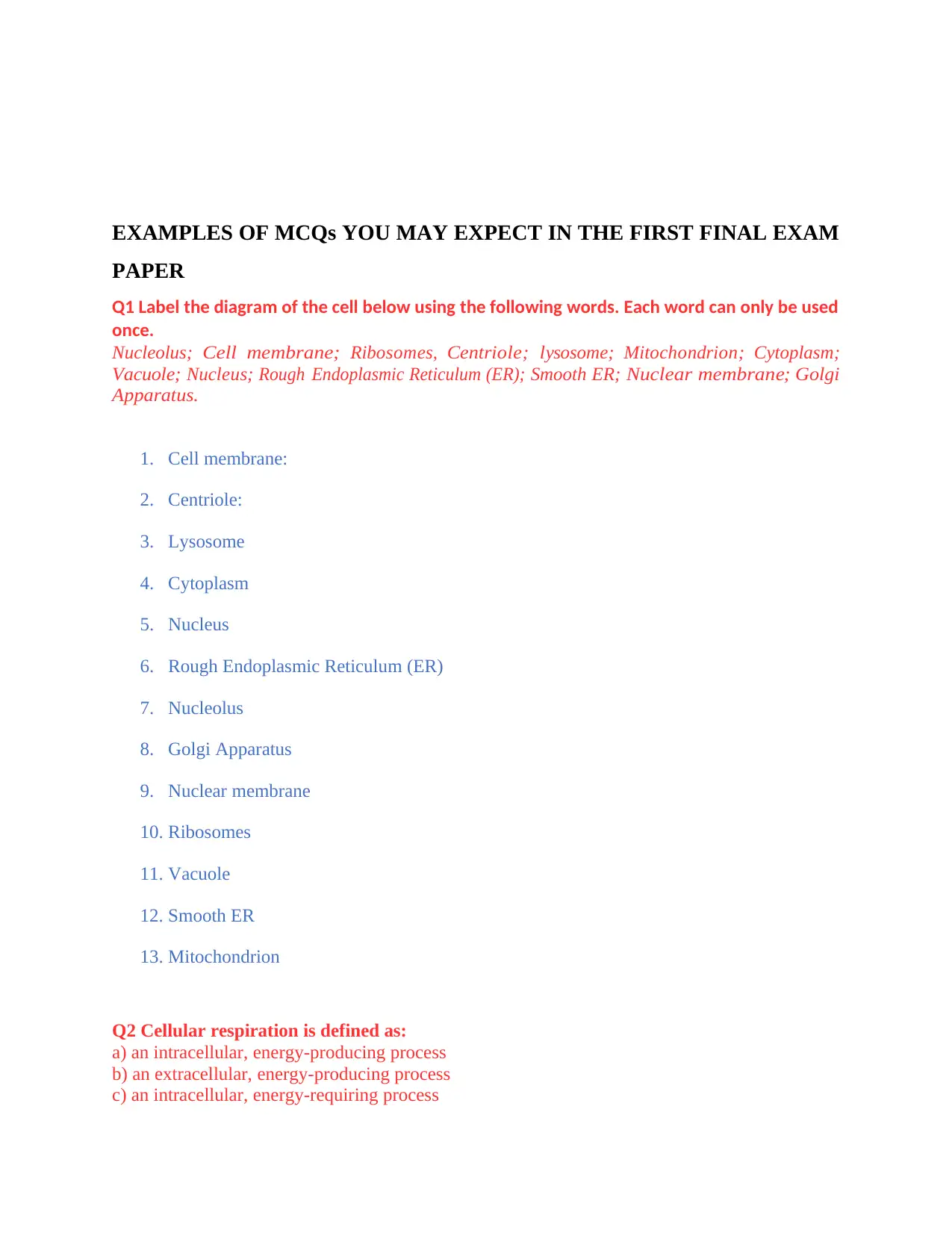
EXAMPLES OF MCQs YOU MAY EXPECT IN THE FIRST FINAL EXAM
PAPER
Q1 Label the diagram of the cell below using the following words. Each word can only be used
once.
Nucleolus; Cell membrane; Ribosomes, Centriole; lysosome; Mitochondrion; Cytoplasm;
Vacuole; Nucleus; Rough Endoplasmic Reticulum (ER); Smooth ER; Nuclear membrane; Golgi
Apparatus.
1. Cell membrane:
2. Centriole:
3. Lysosome
4. Cytoplasm
5. Nucleus
6. Rough Endoplasmic Reticulum (ER)
7. Nucleolus
8. Golgi Apparatus
9. Nuclear membrane
10. Ribosomes
11. Vacuole
12. Smooth ER
13. Mitochondrion
Q2 Cellular respiration is defined as:
a) an intracellular, energy-producing process
b) an extracellular, energy-producing process
c) an intracellular, energy-requiring process
PAPER
Q1 Label the diagram of the cell below using the following words. Each word can only be used
once.
Nucleolus; Cell membrane; Ribosomes, Centriole; lysosome; Mitochondrion; Cytoplasm;
Vacuole; Nucleus; Rough Endoplasmic Reticulum (ER); Smooth ER; Nuclear membrane; Golgi
Apparatus.
1. Cell membrane:
2. Centriole:
3. Lysosome
4. Cytoplasm
5. Nucleus
6. Rough Endoplasmic Reticulum (ER)
7. Nucleolus
8. Golgi Apparatus
9. Nuclear membrane
10. Ribosomes
11. Vacuole
12. Smooth ER
13. Mitochondrion
Q2 Cellular respiration is defined as:
a) an intracellular, energy-producing process
b) an extracellular, energy-producing process
c) an intracellular, energy-requiring process
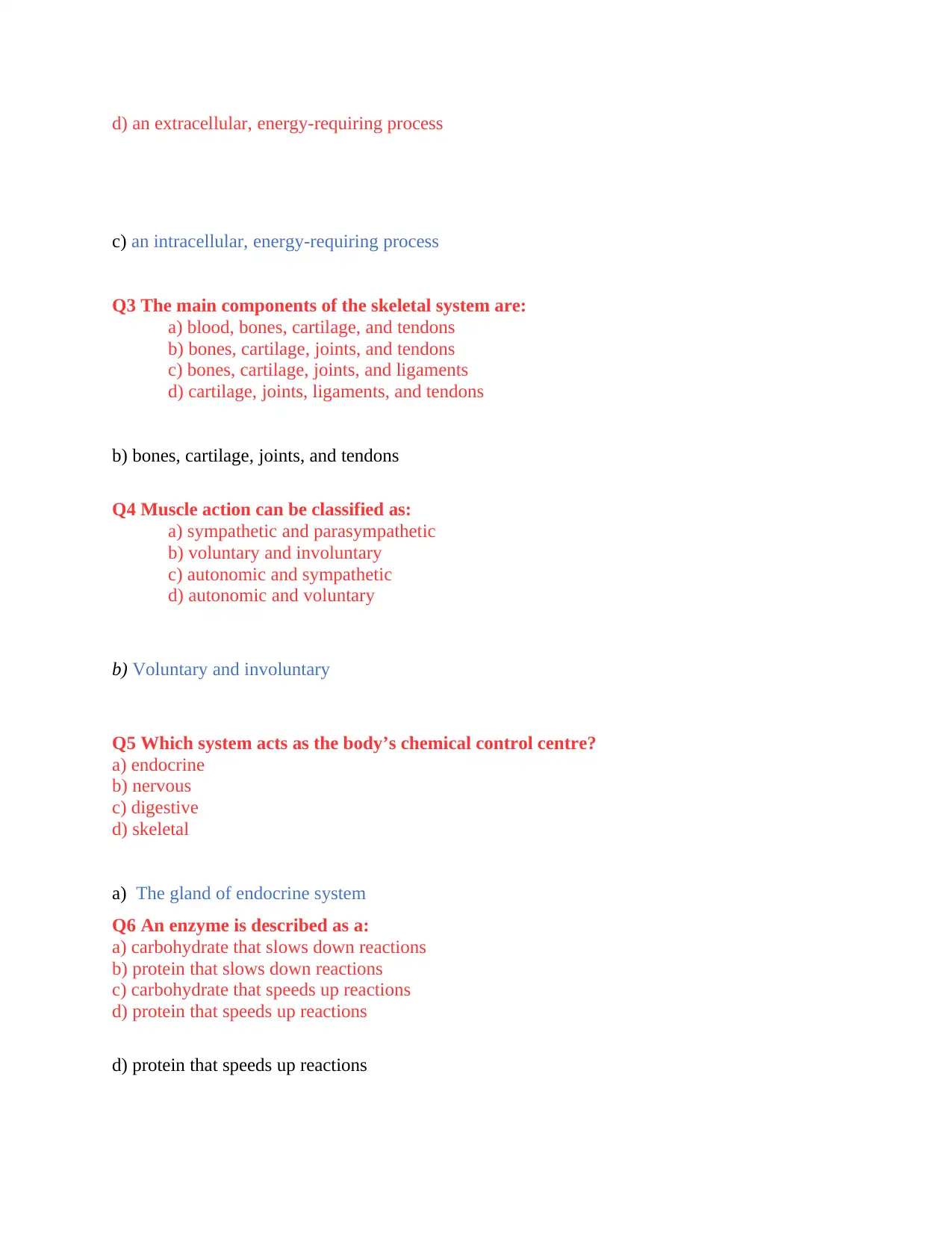
d) an extracellular, energy-requiring process
c) an intracellular, energy-requiring process
Q3 The main components of the skeletal system are:
a) blood, bones, cartilage, and tendons
b) bones, cartilage, joints, and tendons
c) bones, cartilage, joints, and ligaments
d) cartilage, joints, ligaments, and tendons
b) bones, cartilage, joints, and tendons
Q4 Muscle action can be classified as:
a) sympathetic and parasympathetic
b) voluntary and involuntary
c) autonomic and sympathetic
d) autonomic and voluntary
b) Voluntary and involuntary
Q5 Which system acts as the body’s chemical control centre?
a) endocrine
b) nervous
c) digestive
d) skeletal
a) The gland of endocrine system
Q6 An enzyme is described as a:
a) carbohydrate that slows down reactions
b) protein that slows down reactions
c) carbohydrate that speeds up reactions
d) protein that speeds up reactions
d) protein that speeds up reactions
c) an intracellular, energy-requiring process
Q3 The main components of the skeletal system are:
a) blood, bones, cartilage, and tendons
b) bones, cartilage, joints, and tendons
c) bones, cartilage, joints, and ligaments
d) cartilage, joints, ligaments, and tendons
b) bones, cartilage, joints, and tendons
Q4 Muscle action can be classified as:
a) sympathetic and parasympathetic
b) voluntary and involuntary
c) autonomic and sympathetic
d) autonomic and voluntary
b) Voluntary and involuntary
Q5 Which system acts as the body’s chemical control centre?
a) endocrine
b) nervous
c) digestive
d) skeletal
a) The gland of endocrine system
Q6 An enzyme is described as a:
a) carbohydrate that slows down reactions
b) protein that slows down reactions
c) carbohydrate that speeds up reactions
d) protein that speeds up reactions
d) protein that speeds up reactions
⊘ This is a preview!⊘
Do you want full access?
Subscribe today to unlock all pages.

Trusted by 1+ million students worldwide
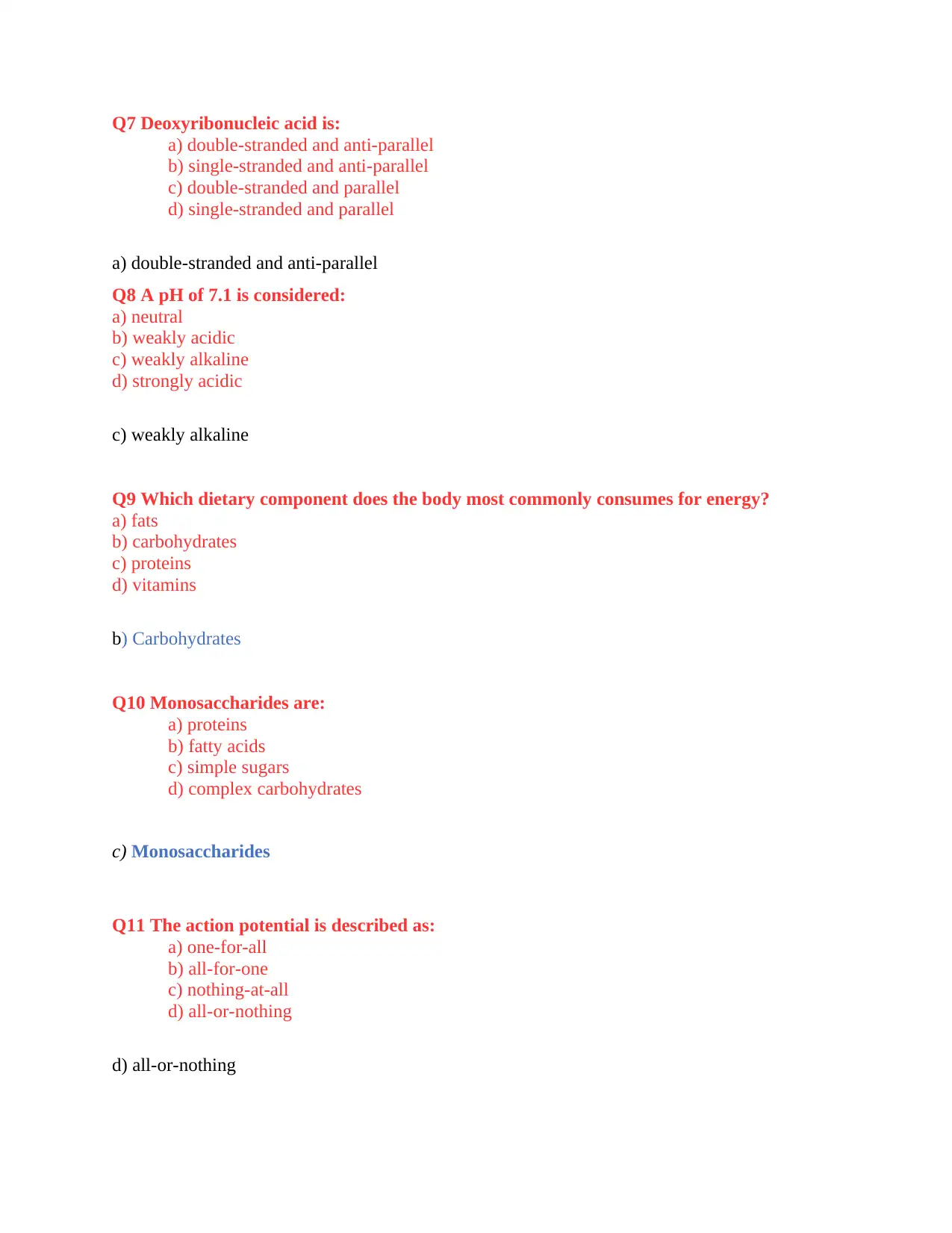
Q7 Deoxyribonucleic acid is:
a) double-stranded and anti-parallel
b) single-stranded and anti-parallel
c) double-stranded and parallel
d) single-stranded and parallel
a) double-stranded and anti-parallel
Q8 A pH of 7.1 is considered:
a) neutral
b) weakly acidic
c) weakly alkaline
d) strongly acidic
c) weakly alkaline
Q9 Which dietary component does the body most commonly consumes for energy?
a) fats
b) carbohydrates
c) proteins
d) vitamins
b) Carbohydrates
Q10 Monosaccharides are:
a) proteins
b) fatty acids
c) simple sugars
d) complex carbohydrates
c) Monosaccharides
Q11 The action potential is described as:
a) one-for-all
b) all-for-one
c) nothing-at-all
d) all-or-nothing
d) all-or-nothing
a) double-stranded and anti-parallel
b) single-stranded and anti-parallel
c) double-stranded and parallel
d) single-stranded and parallel
a) double-stranded and anti-parallel
Q8 A pH of 7.1 is considered:
a) neutral
b) weakly acidic
c) weakly alkaline
d) strongly acidic
c) weakly alkaline
Q9 Which dietary component does the body most commonly consumes for energy?
a) fats
b) carbohydrates
c) proteins
d) vitamins
b) Carbohydrates
Q10 Monosaccharides are:
a) proteins
b) fatty acids
c) simple sugars
d) complex carbohydrates
c) Monosaccharides
Q11 The action potential is described as:
a) one-for-all
b) all-for-one
c) nothing-at-all
d) all-or-nothing
d) all-or-nothing
Paraphrase This Document
Need a fresh take? Get an instant paraphrase of this document with our AI Paraphraser
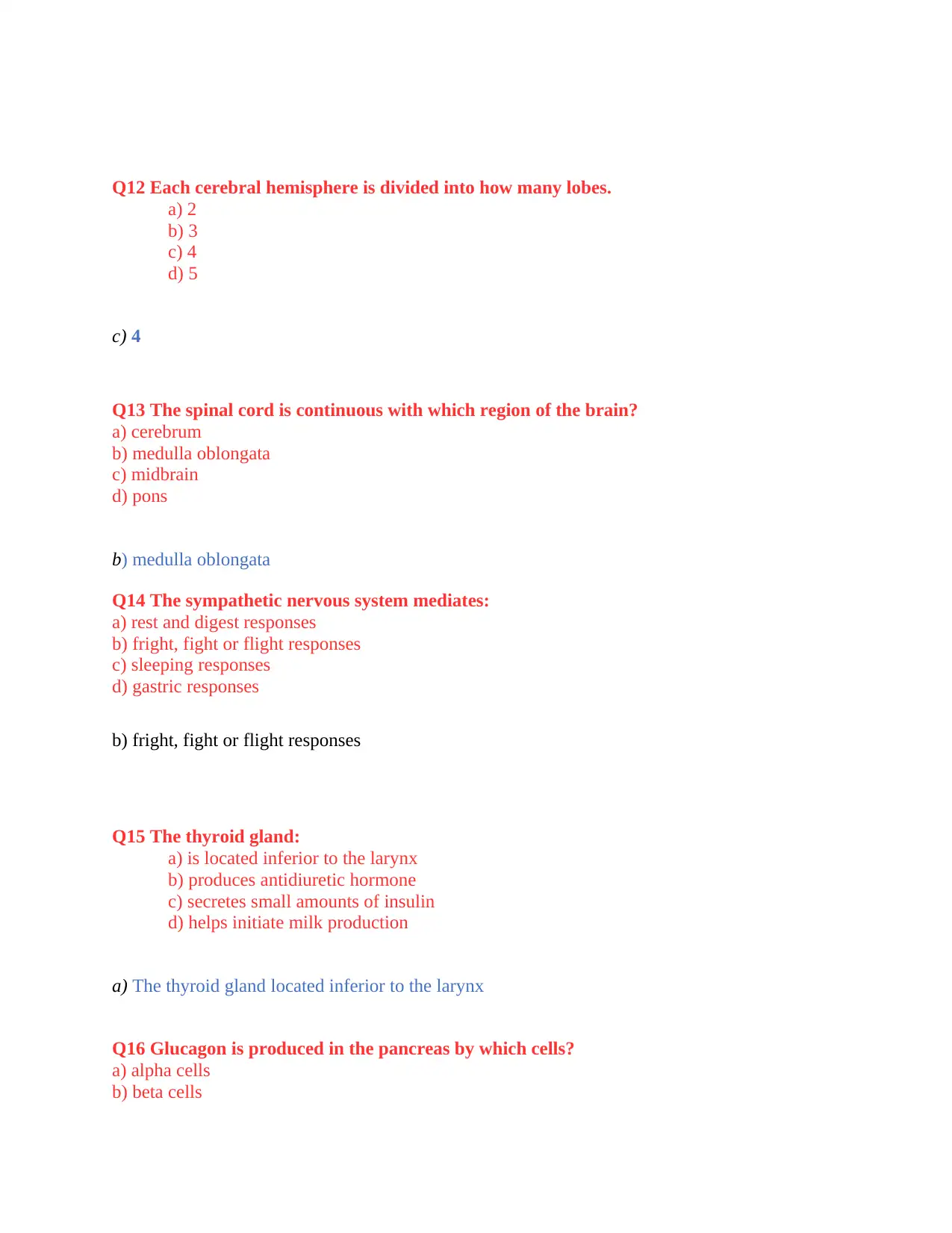
Q12 Each cerebral hemisphere is divided into how many lobes.
a) 2
b) 3
c) 4
d) 5
c) 4
Q13 The spinal cord is continuous with which region of the brain?
a) cerebrum
b) medulla oblongata
c) midbrain
d) pons
b) medulla oblongata
Q14 The sympathetic nervous system mediates:
a) rest and digest responses
b) fright, fight or flight responses
c) sleeping responses
d) gastric responses
b) fright, fight or flight responses
Q15 The thyroid gland:
a) is located inferior to the larynx
b) produces antidiuretic hormone
c) secretes small amounts of insulin
d) helps initiate milk production
a) The thyroid gland located inferior to the larynx
Q16 Glucagon is produced in the pancreas by which cells?
a) alpha cells
b) beta cells
a) 2
b) 3
c) 4
d) 5
c) 4
Q13 The spinal cord is continuous with which region of the brain?
a) cerebrum
b) medulla oblongata
c) midbrain
d) pons
b) medulla oblongata
Q14 The sympathetic nervous system mediates:
a) rest and digest responses
b) fright, fight or flight responses
c) sleeping responses
d) gastric responses
b) fright, fight or flight responses
Q15 The thyroid gland:
a) is located inferior to the larynx
b) produces antidiuretic hormone
c) secretes small amounts of insulin
d) helps initiate milk production
a) The thyroid gland located inferior to the larynx
Q16 Glucagon is produced in the pancreas by which cells?
a) alpha cells
b) beta cells
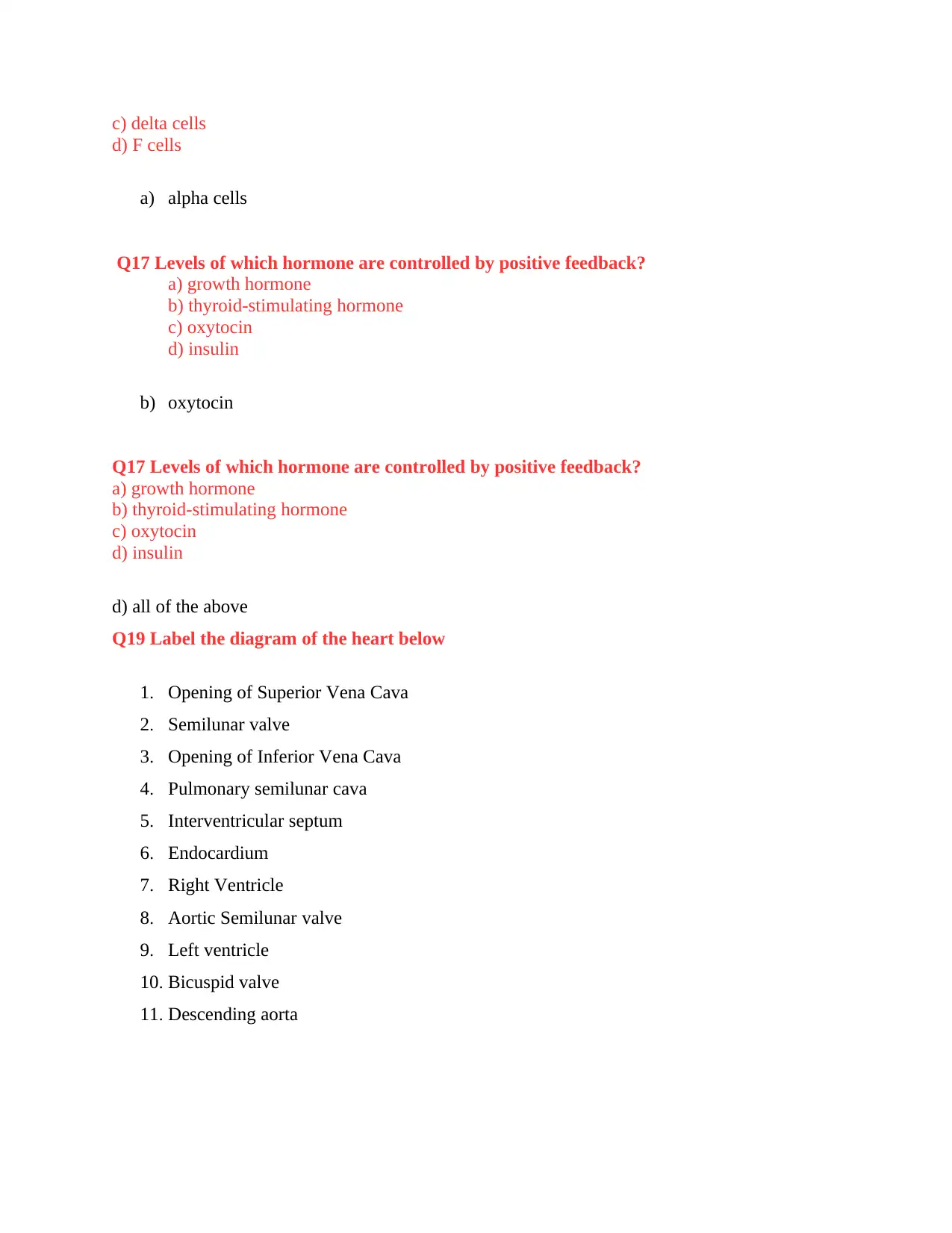
c) delta cells
d) F cells
a) alpha cells
Q17 Levels of which hormone are controlled by positive feedback?
a) growth hormone
b) thyroid-stimulating hormone
c) oxytocin
d) insulin
b) oxytocin
Q17 Levels of which hormone are controlled by positive feedback?
a) growth hormone
b) thyroid-stimulating hormone
c) oxytocin
d) insulin
d) all of the above
Q19 Label the diagram of the heart below
1. Opening of Superior Vena Cava
2. Semilunar valve
3. Opening of Inferior Vena Cava
4. Pulmonary semilunar cava
5. Interventricular septum
6. Endocardium
7. Right Ventricle
8. Aortic Semilunar valve
9. Left ventricle
10. Bicuspid valve
11. Descending aorta
d) F cells
a) alpha cells
Q17 Levels of which hormone are controlled by positive feedback?
a) growth hormone
b) thyroid-stimulating hormone
c) oxytocin
d) insulin
b) oxytocin
Q17 Levels of which hormone are controlled by positive feedback?
a) growth hormone
b) thyroid-stimulating hormone
c) oxytocin
d) insulin
d) all of the above
Q19 Label the diagram of the heart below
1. Opening of Superior Vena Cava
2. Semilunar valve
3. Opening of Inferior Vena Cava
4. Pulmonary semilunar cava
5. Interventricular septum
6. Endocardium
7. Right Ventricle
8. Aortic Semilunar valve
9. Left ventricle
10. Bicuspid valve
11. Descending aorta
⊘ This is a preview!⊘
Do you want full access?
Subscribe today to unlock all pages.

Trusted by 1+ million students worldwide
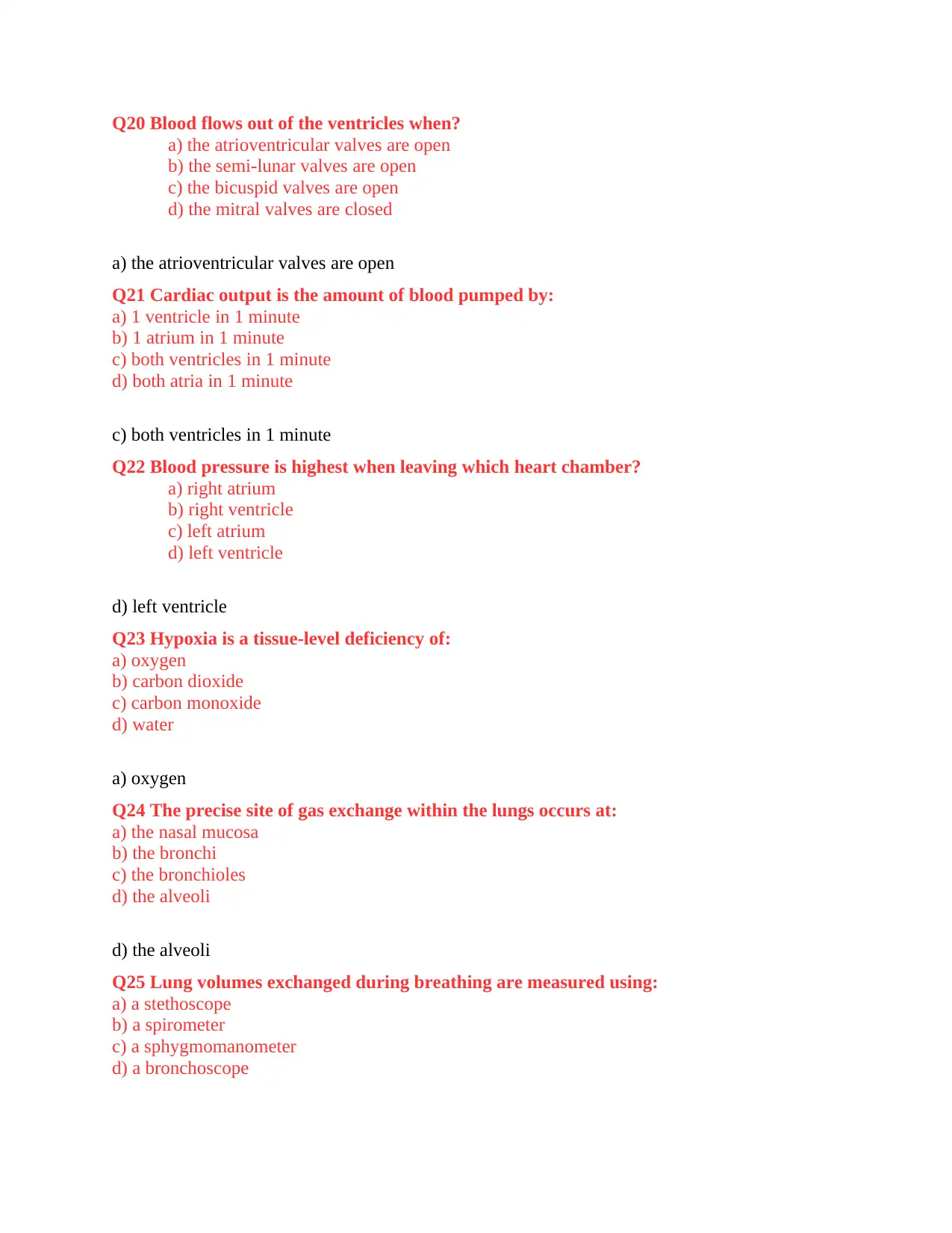
Q20 Blood flows out of the ventricles when?
a) the atrioventricular valves are open
b) the semi-lunar valves are open
c) the bicuspid valves are open
d) the mitral valves are closed
a) the atrioventricular valves are open
Q21 Cardiac output is the amount of blood pumped by:
a) 1 ventricle in 1 minute
b) 1 atrium in 1 minute
c) both ventricles in 1 minute
d) both atria in 1 minute
c) both ventricles in 1 minute
Q22 Blood pressure is highest when leaving which heart chamber?
a) right atrium
b) right ventricle
c) left atrium
d) left ventricle
d) left ventricle
Q23 Hypoxia is a tissue-level deficiency of:
a) oxygen
b) carbon dioxide
c) carbon monoxide
d) water
a) oxygen
Q24 The precise site of gas exchange within the lungs occurs at:
a) the nasal mucosa
b) the bronchi
c) the bronchioles
d) the alveoli
d) the alveoli
Q25 Lung volumes exchanged during breathing are measured using:
a) a stethoscope
b) a spirometer
c) a sphygmomanometer
d) a bronchoscope
a) the atrioventricular valves are open
b) the semi-lunar valves are open
c) the bicuspid valves are open
d) the mitral valves are closed
a) the atrioventricular valves are open
Q21 Cardiac output is the amount of blood pumped by:
a) 1 ventricle in 1 minute
b) 1 atrium in 1 minute
c) both ventricles in 1 minute
d) both atria in 1 minute
c) both ventricles in 1 minute
Q22 Blood pressure is highest when leaving which heart chamber?
a) right atrium
b) right ventricle
c) left atrium
d) left ventricle
d) left ventricle
Q23 Hypoxia is a tissue-level deficiency of:
a) oxygen
b) carbon dioxide
c) carbon monoxide
d) water
a) oxygen
Q24 The precise site of gas exchange within the lungs occurs at:
a) the nasal mucosa
b) the bronchi
c) the bronchioles
d) the alveoli
d) the alveoli
Q25 Lung volumes exchanged during breathing are measured using:
a) a stethoscope
b) a spirometer
c) a sphygmomanometer
d) a bronchoscope
Paraphrase This Document
Need a fresh take? Get an instant paraphrase of this document with our AI Paraphraser
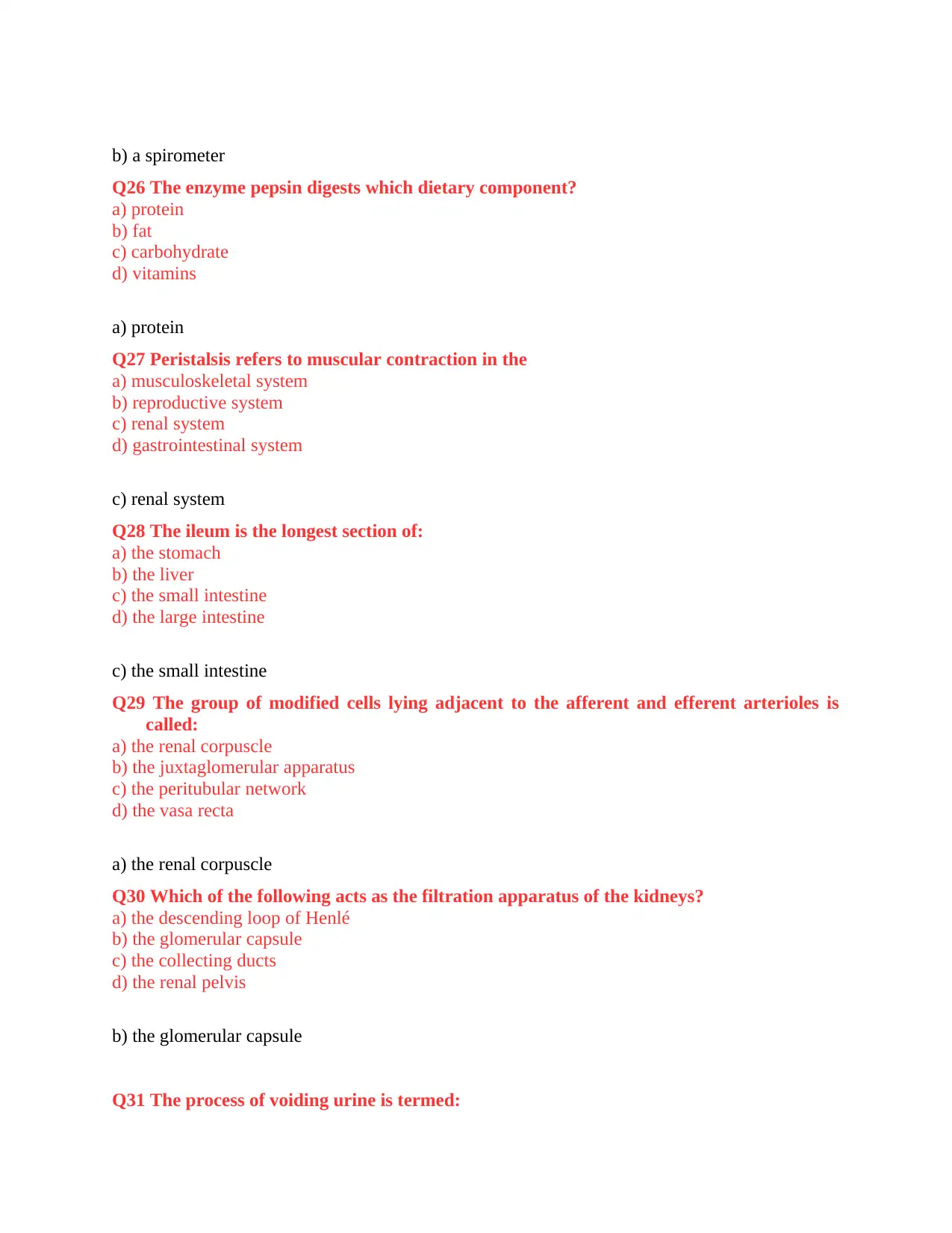
b) a spirometer
Q26 The enzyme pepsin digests which dietary component?
a) protein
b) fat
c) carbohydrate
d) vitamins
a) protein
Q27 Peristalsis refers to muscular contraction in the
a) musculoskeletal system
b) reproductive system
c) renal system
d) gastrointestinal system
c) renal system
Q28 The ileum is the longest section of:
a) the stomach
b) the liver
c) the small intestine
d) the large intestine
c) the small intestine
Q29 The group of modified cells lying adjacent to the afferent and efferent arterioles is
called:
a) the renal corpuscle
b) the juxtaglomerular apparatus
c) the peritubular network
d) the vasa recta
a) the renal corpuscle
Q30 Which of the following acts as the filtration apparatus of the kidneys?
a) the descending loop of Henlé
b) the glomerular capsule
c) the collecting ducts
d) the renal pelvis
b) the glomerular capsule
Q31 The process of voiding urine is termed:
Q26 The enzyme pepsin digests which dietary component?
a) protein
b) fat
c) carbohydrate
d) vitamins
a) protein
Q27 Peristalsis refers to muscular contraction in the
a) musculoskeletal system
b) reproductive system
c) renal system
d) gastrointestinal system
c) renal system
Q28 The ileum is the longest section of:
a) the stomach
b) the liver
c) the small intestine
d) the large intestine
c) the small intestine
Q29 The group of modified cells lying adjacent to the afferent and efferent arterioles is
called:
a) the renal corpuscle
b) the juxtaglomerular apparatus
c) the peritubular network
d) the vasa recta
a) the renal corpuscle
Q30 Which of the following acts as the filtration apparatus of the kidneys?
a) the descending loop of Henlé
b) the glomerular capsule
c) the collecting ducts
d) the renal pelvis
b) the glomerular capsule
Q31 The process of voiding urine is termed:
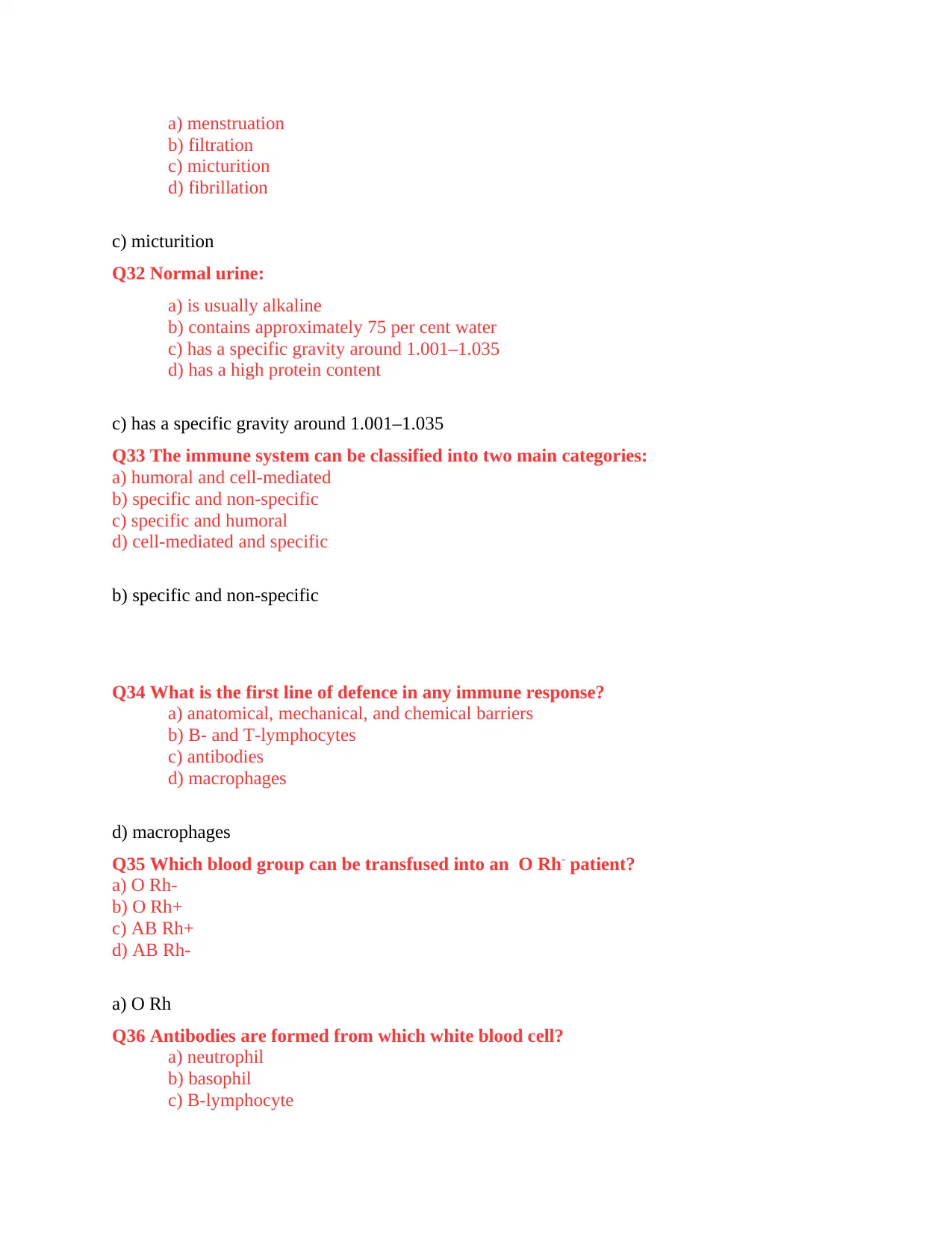
a) menstruation
b) filtration
c) micturition
d) fibrillation
c) micturition
Q32 Normal urine:
a) is usually alkaline
b) contains approximately 75 per cent water
c) has a specific gravity around 1.001–1.035
d) has a high protein content
c) has a specific gravity around 1.001–1.035
Q33 The immune system can be classified into two main categories:
a) humoral and cell-mediated
b) specific and non-specific
c) specific and humoral
d) cell-mediated and specific
b) specific and non-specific
Q34 What is the first line of defence in any immune response?
a) anatomical, mechanical, and chemical barriers
b) B- and T-lymphocytes
c) antibodies
d) macrophages
d) macrophages
Q35 Which blood group can be transfused into an O Rh- patient?
a) O Rh-
b) O Rh+
c) AB Rh+
d) AB Rh-
a) O Rh
Q36 Antibodies are formed from which white blood cell?
a) neutrophil
b) basophil
c) B-lymphocyte
b) filtration
c) micturition
d) fibrillation
c) micturition
Q32 Normal urine:
a) is usually alkaline
b) contains approximately 75 per cent water
c) has a specific gravity around 1.001–1.035
d) has a high protein content
c) has a specific gravity around 1.001–1.035
Q33 The immune system can be classified into two main categories:
a) humoral and cell-mediated
b) specific and non-specific
c) specific and humoral
d) cell-mediated and specific
b) specific and non-specific
Q34 What is the first line of defence in any immune response?
a) anatomical, mechanical, and chemical barriers
b) B- and T-lymphocytes
c) antibodies
d) macrophages
d) macrophages
Q35 Which blood group can be transfused into an O Rh- patient?
a) O Rh-
b) O Rh+
c) AB Rh+
d) AB Rh-
a) O Rh
Q36 Antibodies are formed from which white blood cell?
a) neutrophil
b) basophil
c) B-lymphocyte
⊘ This is a preview!⊘
Do you want full access?
Subscribe today to unlock all pages.

Trusted by 1+ million students worldwide
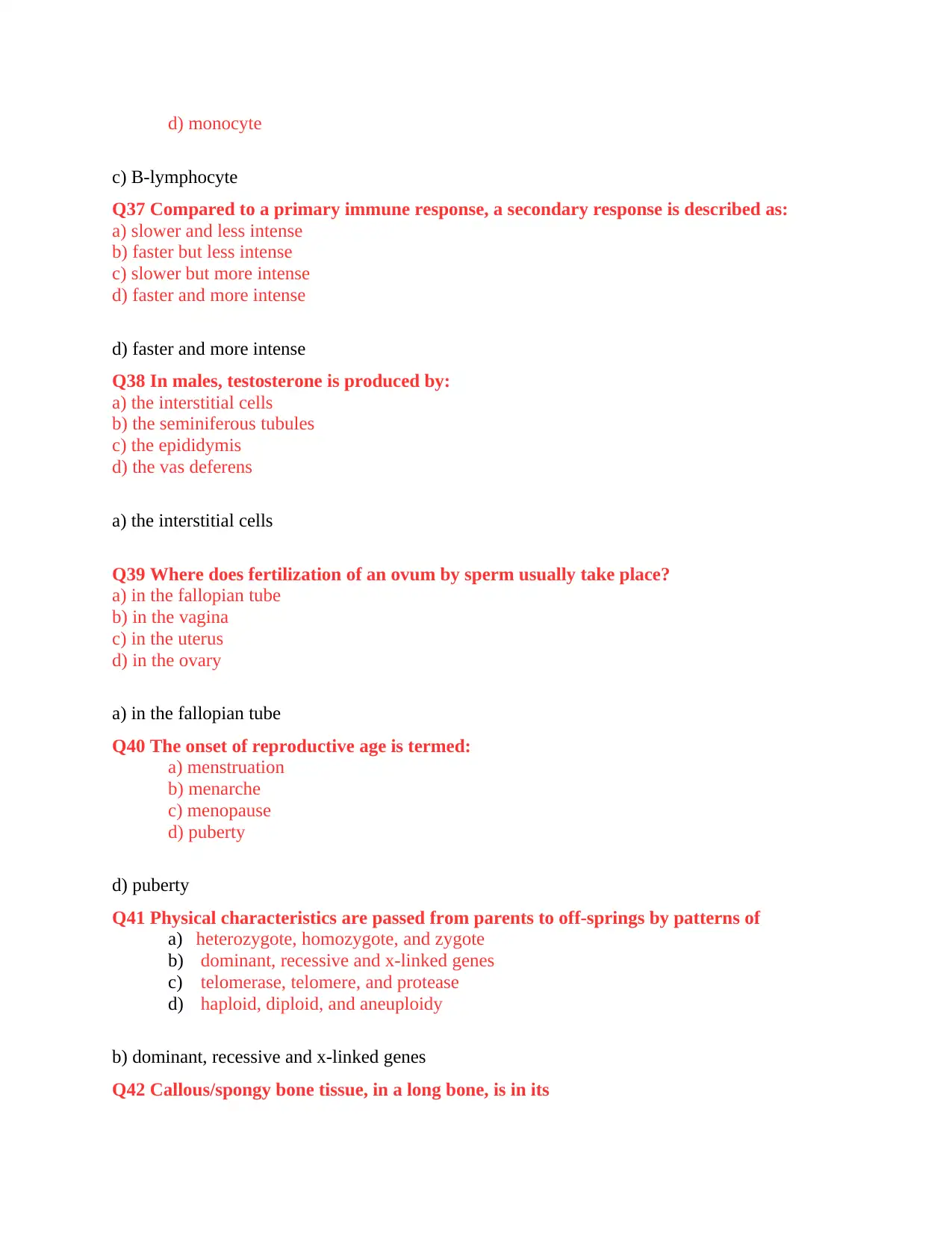
d) monocyte
c) B-lymphocyte
Q37 Compared to a primary immune response, a secondary response is described as:
a) slower and less intense
b) faster but less intense
c) slower but more intense
d) faster and more intense
d) faster and more intense
Q38 In males, testosterone is produced by:
a) the interstitial cells
b) the seminiferous tubules
c) the epididymis
d) the vas deferens
a) the interstitial cells
Q39 Where does fertilization of an ovum by sperm usually take place?
a) in the fallopian tube
b) in the vagina
c) in the uterus
d) in the ovary
a) in the fallopian tube
Q40 The onset of reproductive age is termed:
a) menstruation
b) menarche
c) menopause
d) puberty
d) puberty
Q41 Physical characteristics are passed from parents to off-springs by patterns of
a) heterozygote, homozygote, and zygote
b) dominant, recessive and x-linked genes
c) telomerase, telomere, and protease
d) haploid, diploid, and aneuploidy
b) dominant, recessive and x-linked genes
Q42 Callous/spongy bone tissue, in a long bone, is in its
c) B-lymphocyte
Q37 Compared to a primary immune response, a secondary response is described as:
a) slower and less intense
b) faster but less intense
c) slower but more intense
d) faster and more intense
d) faster and more intense
Q38 In males, testosterone is produced by:
a) the interstitial cells
b) the seminiferous tubules
c) the epididymis
d) the vas deferens
a) the interstitial cells
Q39 Where does fertilization of an ovum by sperm usually take place?
a) in the fallopian tube
b) in the vagina
c) in the uterus
d) in the ovary
a) in the fallopian tube
Q40 The onset of reproductive age is termed:
a) menstruation
b) menarche
c) menopause
d) puberty
d) puberty
Q41 Physical characteristics are passed from parents to off-springs by patterns of
a) heterozygote, homozygote, and zygote
b) dominant, recessive and x-linked genes
c) telomerase, telomere, and protease
d) haploid, diploid, and aneuploidy
b) dominant, recessive and x-linked genes
Q42 Callous/spongy bone tissue, in a long bone, is in its
Paraphrase This Document
Need a fresh take? Get an instant paraphrase of this document with our AI Paraphraser
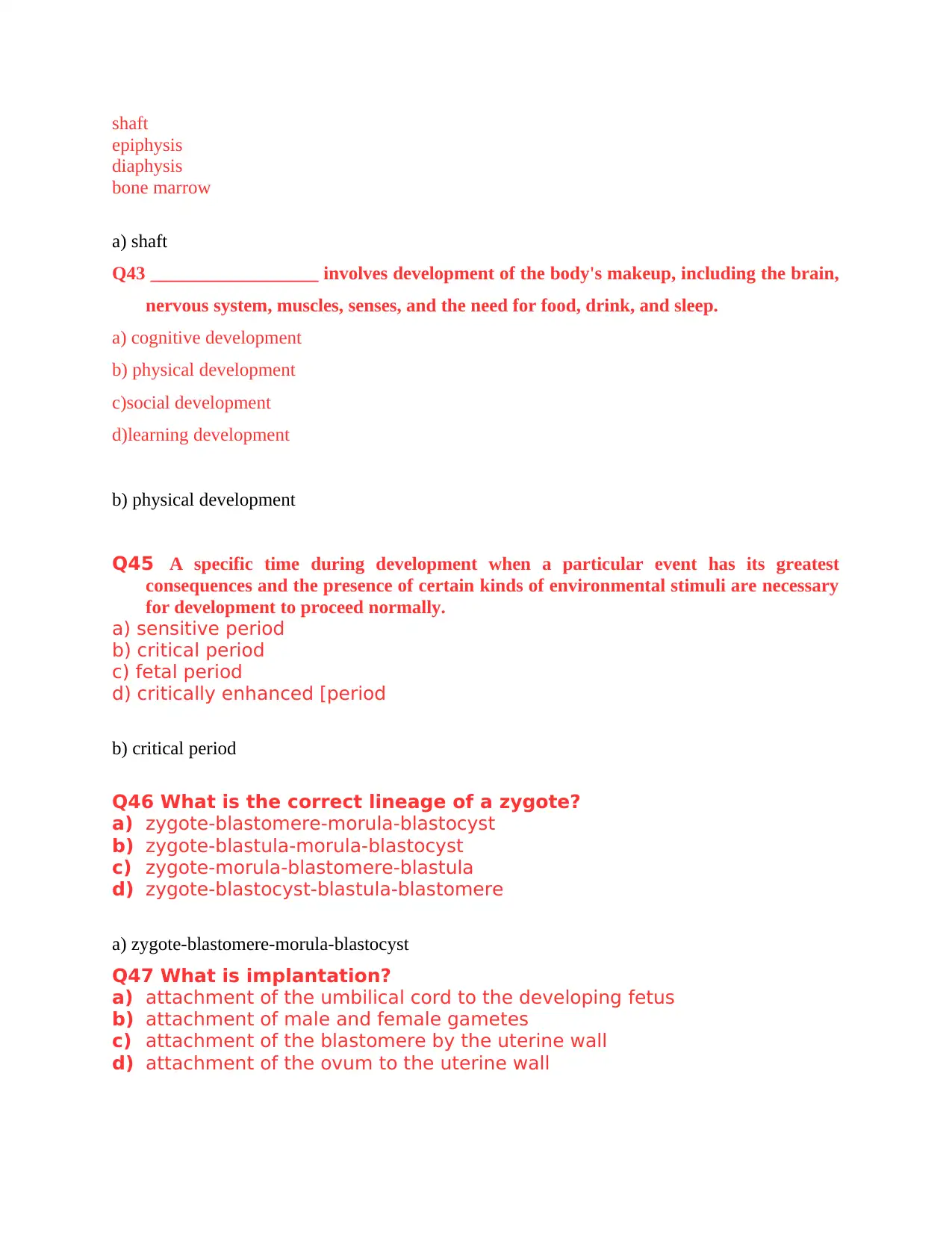
shaft
epiphysis
diaphysis
bone marrow
a) shaft
Q43 __________________ involves development of the body's makeup, including the brain,
nervous system, muscles, senses, and the need for food, drink, and sleep.
a) cognitive development
b) physical development
c)social development
d)learning development
b) physical development
Q45 A specific time during development when a particular event has its greatest
consequences and the presence of certain kinds of environmental stimuli are necessary
for development to proceed normally.
a) sensitive period
b) critical period
c) fetal period
d) critically enhanced [period
b) critical period
Q46 What is the correct lineage of a zygote?
a) zygote-blastomere-morula-blastocyst
b) zygote-blastula-morula-blastocyst
c) zygote-morula-blastomere-blastula
d) zygote-blastocyst-blastula-blastomere
a) zygote-blastomere-morula-blastocyst
Q47 What is implantation?
a) attachment of the umbilical cord to the developing fetus
b) attachment of male and female gametes
c) attachment of the blastomere by the uterine wall
d) attachment of the ovum to the uterine wall
epiphysis
diaphysis
bone marrow
a) shaft
Q43 __________________ involves development of the body's makeup, including the brain,
nervous system, muscles, senses, and the need for food, drink, and sleep.
a) cognitive development
b) physical development
c)social development
d)learning development
b) physical development
Q45 A specific time during development when a particular event has its greatest
consequences and the presence of certain kinds of environmental stimuli are necessary
for development to proceed normally.
a) sensitive period
b) critical period
c) fetal period
d) critically enhanced [period
b) critical period
Q46 What is the correct lineage of a zygote?
a) zygote-blastomere-morula-blastocyst
b) zygote-blastula-morula-blastocyst
c) zygote-morula-blastomere-blastula
d) zygote-blastocyst-blastula-blastomere
a) zygote-blastomere-morula-blastocyst
Q47 What is implantation?
a) attachment of the umbilical cord to the developing fetus
b) attachment of male and female gametes
c) attachment of the blastomere by the uterine wall
d) attachment of the ovum to the uterine wall
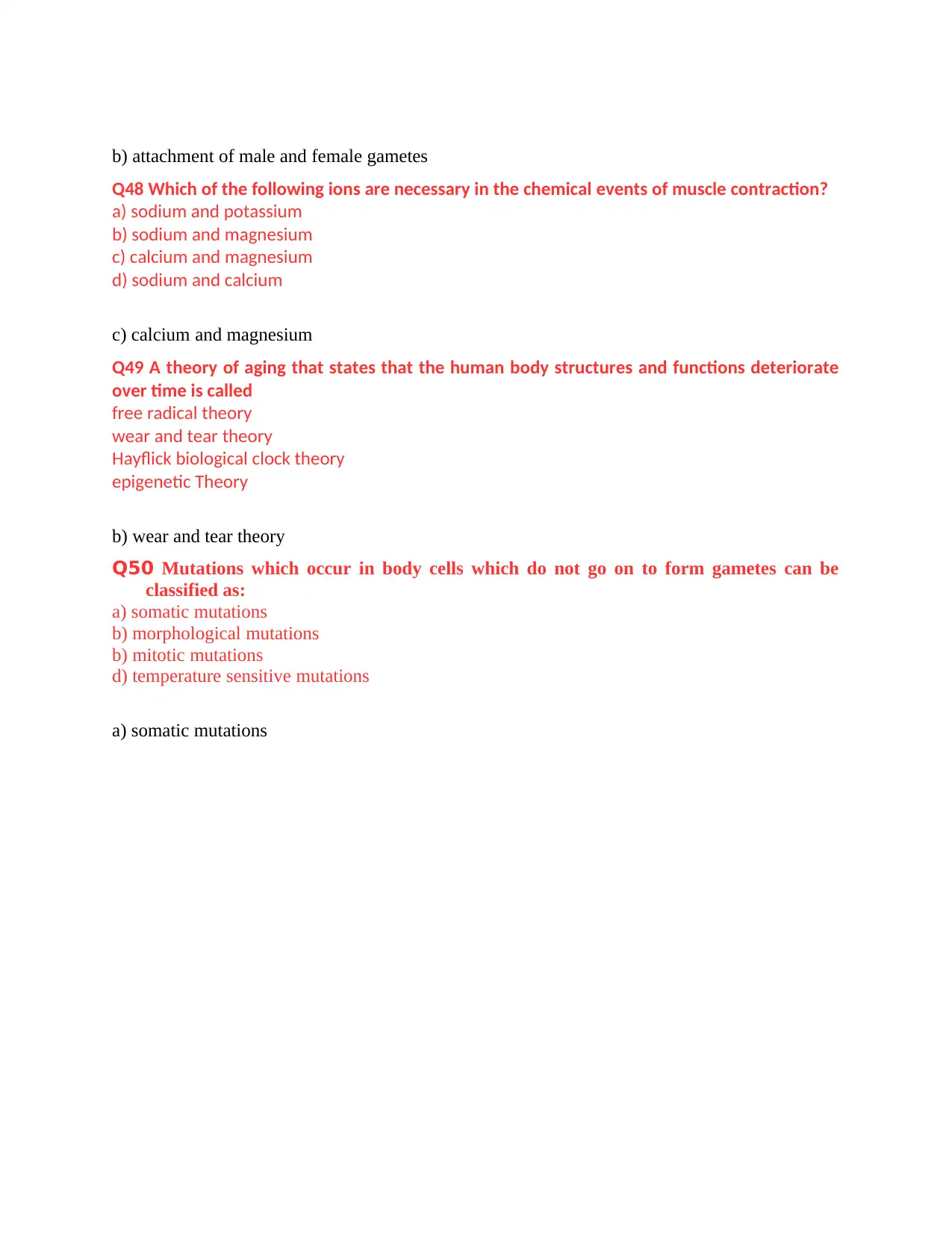
b) attachment of male and female gametes
Q48 Which of the following ions are necessary in the chemical events of muscle contraction?
a) sodium and potassium
b) sodium and magnesium
c) calcium and magnesium
d) sodium and calcium
c) calcium and magnesium
Q49 A theory of aging that states that the human body structures and functions deteriorate
over time is called
free radical theory
wear and tear theory
Hayflick biological clock theory
epigenetic Theory
b) wear and tear theory
Q50 Mutations which occur in body cells which do not go on to form gametes can be
classified as:
a) somatic mutations
b) morphological mutations
b) mitotic mutations
d) temperature sensitive mutations
a) somatic mutations
Q48 Which of the following ions are necessary in the chemical events of muscle contraction?
a) sodium and potassium
b) sodium and magnesium
c) calcium and magnesium
d) sodium and calcium
c) calcium and magnesium
Q49 A theory of aging that states that the human body structures and functions deteriorate
over time is called
free radical theory
wear and tear theory
Hayflick biological clock theory
epigenetic Theory
b) wear and tear theory
Q50 Mutations which occur in body cells which do not go on to form gametes can be
classified as:
a) somatic mutations
b) morphological mutations
b) mitotic mutations
d) temperature sensitive mutations
a) somatic mutations
⊘ This is a preview!⊘
Do you want full access?
Subscribe today to unlock all pages.

Trusted by 1+ million students worldwide
1 out of 21
Your All-in-One AI-Powered Toolkit for Academic Success.
+13062052269
info@desklib.com
Available 24*7 on WhatsApp / Email
![[object Object]](/_next/static/media/star-bottom.7253800d.svg)
Unlock your academic potential
Copyright © 2020–2025 A2Z Services. All Rights Reserved. Developed and managed by ZUCOL.
